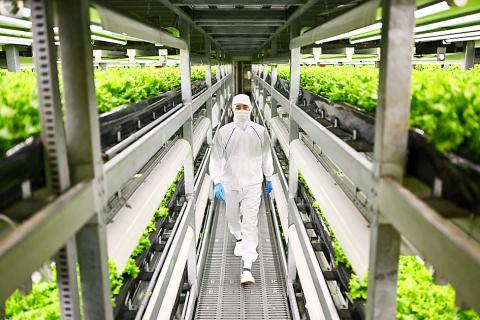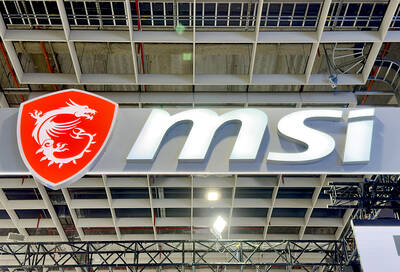The nondescript building on an industrial site near Kyoto gave little hint to the productivity inside: 30,000 heads of lettuce grow inside daily, under artificial light and with barely any human intervention.
This “vegetable factory,” using the latest vertical farming techniques, is part of a trend born out of necessity in Japan, where traditional farming faces a double threat from the aging population and migration toward cities.
With the average age of a farmer in Japan at 67 and few candidates to replace those dying out, the country has been forced to become a pioneer in so-called vertical farming.

Photo: AFP
Globally renowned firms such as Panasonic Corp, Toshiba Corp and Fujitsu Ltd have tried their hand — converting old semiconductor production lines with varying levels of success.
One of the few companies to turn a quick profit, Spread Co Ltd produces 11 million heads of lettuce annually from its latest factory in Kyoto, a vast sterile area where the vegetables are stacked on shelves several meters high.
Machines shift the lettuces around the factory to areas where the light, temperature and humidity are ideal for that stage of growth. The process works without soil or pesticides, and only a dozen or so humans are employed to collect the lettuce at the end.
Other countries have employed vertical farming techniques — notably Denmark and the US — but Japan’s population crisis means that farmers are dying out, with question marks over how the world’s third-biggest economy will feed itself.
“Given the lack of manpower and decline in agricultural production, I felt a new system was needed,” Spread CEO Shinji Inada told reporters.
Spread has taken some time to make the process nearly fully automated: An older factory in Kyoto still employs several dozen humans to move the lettuce — a “difficult task,” one staff member said.
However, the advantages are clear.
“We can produce in large quantities and at a stable rate all year round, without being affected by temperature changes,” Inada said.
“The other benefit is that we have few losses, because our products are preserved for longer,” the vegetable tycoon added.
The firm initially experienced some difficulty in selling the lettuce, Inada said, but added that it has now grown a good brand by producing consistent quality at a consistent price — in a country where prices vary considerably depending on the season.
Spread’s lettuce is found on supermarket shelves in Kyoto and the capital, Tokyo, and Inada has grand expansion visions to move production closer to where the vegetables are consumed.
The firm is building a factory in Narita near Tokyo and is eyeing further afield to countries where the climate is not suited for such agriculture.
“We can easily export our production system to very warm or very cold climates to grow lettuce,” Inada said.
However, is this system environmentally friendly?
Inada said that he hesitated before launching the concept over this very question, but finally reasoned the pros outweighed the cons.
“It’s true that we use more energy compared to production using the sun, but on the other hand our productivity is higher over a similar surface area,” he said.
The system allows the firm to produce eight crops of lettuce per year, irrespective of the season. Spread also uses significantly less water than traditional agricultural methods.
“I believe we are contributing to a sustainable agriculture for our society,” Inada said.
Japan already has about 200 lettuce factories using artificial light, the majority of which are small-scale, but specialist consultancy group Innoplex LLC said that such factories would double in number by 2025.
Other companies are jumping on the smart agriculture bandwagon, with Mitsubishi Gas Chemical Co Inc building a factory in northeastern Fukushima that is to produce 32,000 heads of lettuce daily.
Nor is it just lettuce: tomatoes and strawberries grown by computer under artificial light are on their way to a table near you.

DIVIDED VIEWS: Although the Fed agreed on holding rates steady, some officials see no rate cuts for this year, while 10 policymakers foresee two or more cuts There are a lot of unknowns about the outlook for the economy and interest rates, but US Federal Reserve Chair Jerome Powell signaled at least one thing seems certain: Higher prices are coming. Fed policymakers voted unanimously to hold interest rates steady at a range of 4.25 percent to 4.50 percent for a fourth straight meeting on Wednesday, as they await clarity on whether tariffs would leave a one-time or more lasting mark on inflation. Powell said it is still unclear how much of the bill would fall on the shoulders of consumers, but he expects to learn more about tariffs

NOT JUSTIFIED: The bank’s governor said there would only be a rate cut if inflation falls below 1.5% and economic conditions deteriorate, which have not been detected The central bank yesterday kept its key interest rates unchanged for a fifth consecutive quarter, aligning with market expectations, while slightly lowering its inflation outlook amid signs of cooling price pressures. The move came after the US Federal Reserve held rates steady overnight, despite pressure from US President Donald Trump to cut borrowing costs. Central bank board members unanimously voted to maintain the discount rate at 2 percent, the secured loan rate at 2.375 percent and the overnight lending rate at 4.25 percent. “We consider the policy decision appropriate, although it suggests tightening leaning after factoring in slackening inflation and stable GDP growth,”

Meta Platforms Inc offered US$100 million bonuses to OpenAI employees in an unsuccessful bid to poach the ChatGPT maker’s talent and strengthen its own generative artificial intelligence (AI) teams, OpenAI CEO Sam Altman has said. Facebook’s parent company — a competitor of OpenAI — also offered “giant” annual salaries exceeding US$100 million to OpenAI staffers, Altman said in an interview on the Uncapped with Jack Altman podcast released on Tuesday. “It is crazy,” Sam Altman told his brother Jack in the interview. “I’m really happy that at least so far none of our best people have decided to take them

PLANS: MSI is also planning to upgrade its service center in the Netherlands Micro-Star International Co (MSI, 微星) yesterday said it plans to set up a server assembly line at its Poland service center this year at the earliest. The computer and peripherals manufacturer expects that the new server assembly line would shorten transportation times in shipments to European countries, a company spokesperson told the Taipei Times by telephone. MSI manufactures motherboards, graphics cards, notebook computers, servers, optical storage devices and communication devices. The company operates plants in Taiwan and China, and runs a global network of service centers. The company is also considering upgrading its service center in the Netherlands into a